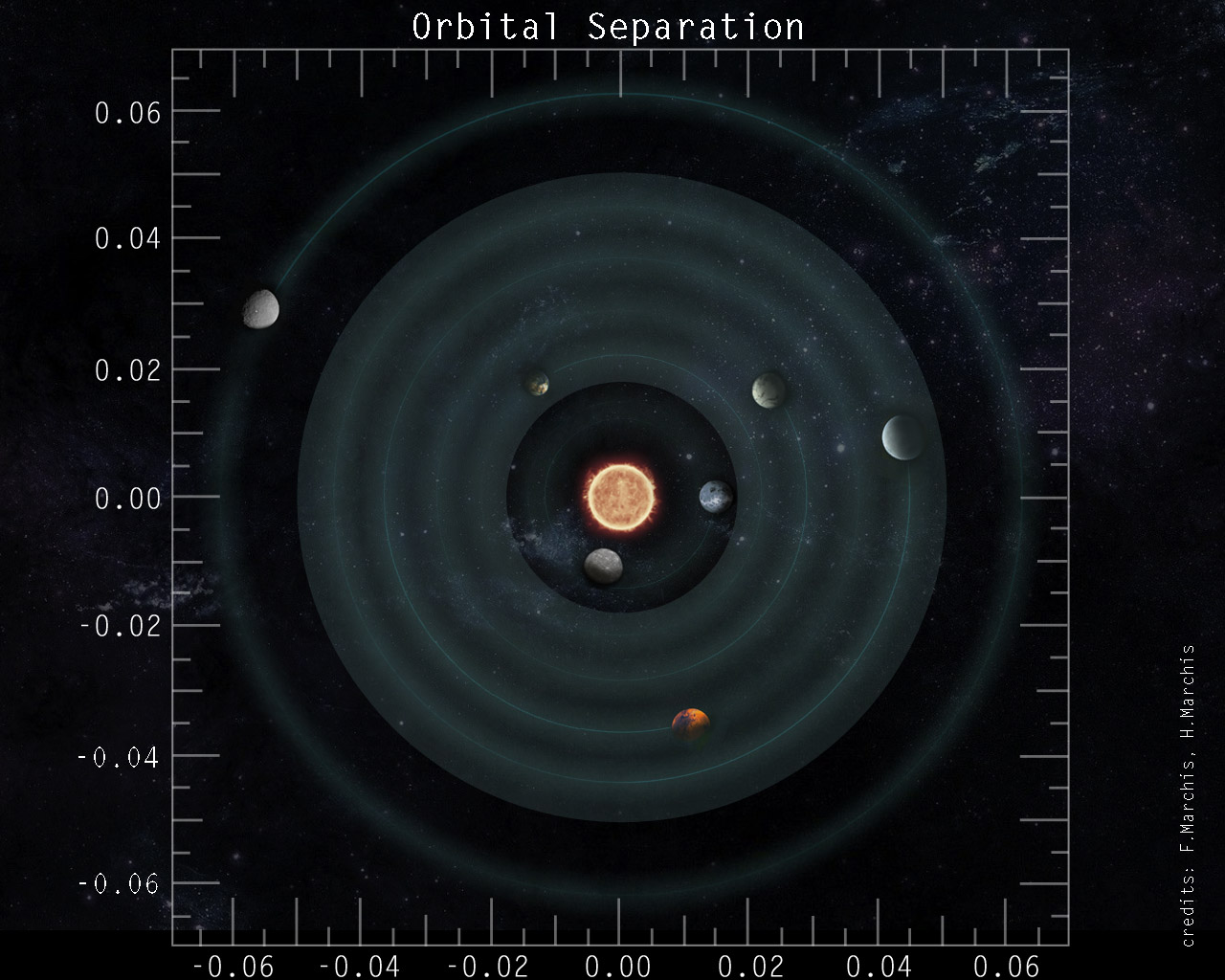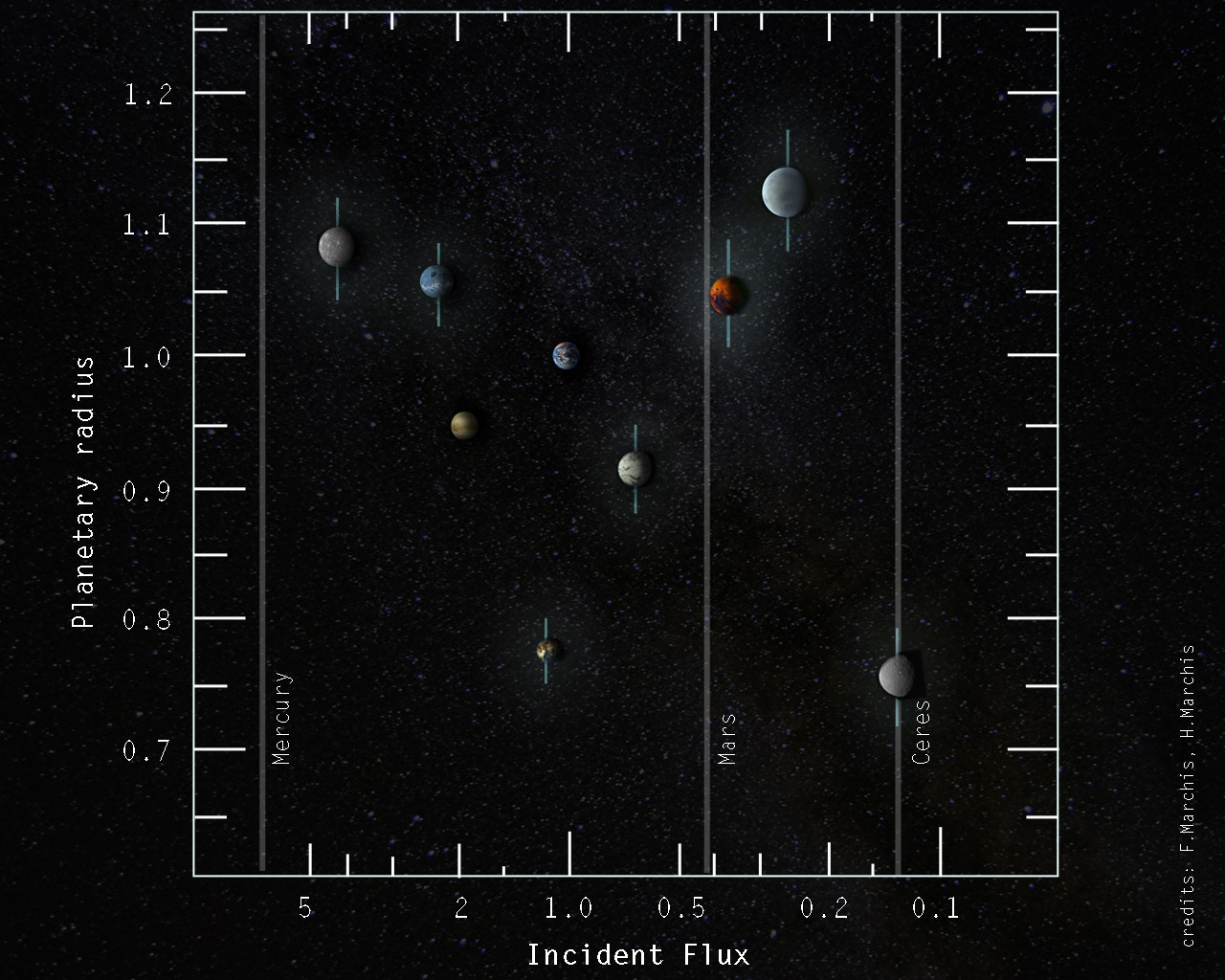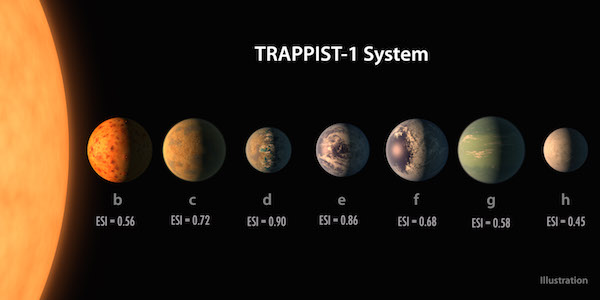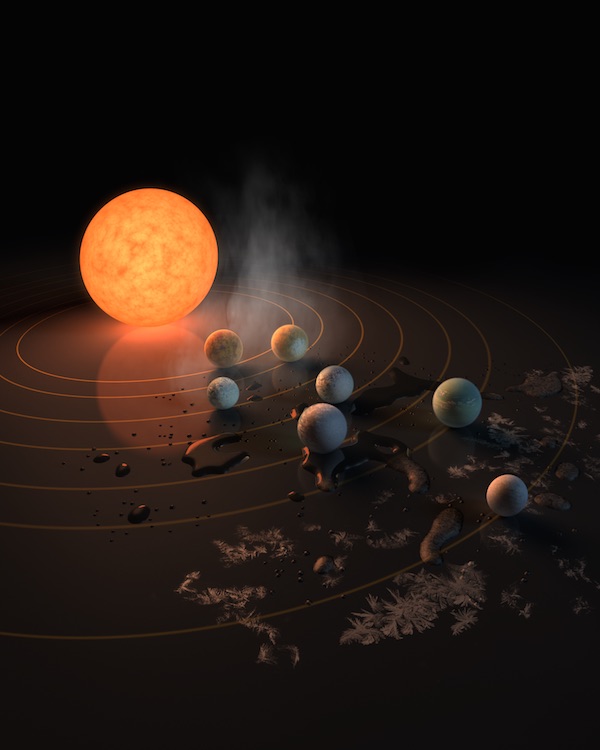Wonderful Potentially Habitable Worlds Around TRAPPIST-1

Mid-infrared light reveals a contaminated crust around Ceres
January 19, 2017
Another smoking gun in the search for life in Enceladus’ ocean
April 13, 2017In May 2016, Michael Gillon and his team announced the discovery of three Earth-sized exoplanets around TRAPPIST-1, an ultra cool M-dwarf star, using the small TRAPPIST telescope at ESO-La Silla, Chile. It was an exciting discovery—yet on that day no one could possibly have imagined that less than a year later they would make another significant discovery involving the same system. But here we are: today, they announced in Nature the discovery of seven potentially habitable Earth-like worlds.
The star, named TRAPPIST-1, is a fairly inconspicuous star in our Milky Way. Small (8% the mass of the sun) and cold (half the temperature of the sun), it is a member of an ultra-cool dwarf population that represents 15% of the star population of our galaxy. In 2016, Gillon and his team detected the transit (i.e., the shadow of a planet passing between its host star and us) of three exoplanets at the inner edge of the habitable zone of their star.
Energized and excited by this discovery, the team requested and received additional telescope time to follow up on this system during the second half of 2016. The NASA Spitzer telescope is one of the facilities they selected for an ambitious program that called for monitoring the TRAPPIST-1 system almost continuously for twenty days. Spitzer and other ground-based telescopes allowed the team to detect thirty-four transits, more than they had anticipated, suggesting the existence of additional exoplanets in the system.
After an careful analysis, the data revealed the presence of seven Earth-sized exoplanets (named TRAPPIST 1b, c, d, e, f, g, and h) in orbit around this M-type star. Because their orbital periods are short (less than twelve days for planets b to g), several transits were detected during the campaign. Accurately measurements of those tiny events (0.6% dimming of the star) provide a wealth of information about the planets’ orbits, sizes, and even masses by measuring precisely the timings of the transits which are perturbed by the gravity of other planets.

Top view of the TRAPPIST-1 planetary system showing the circular orbits of the seven Earth-like exoplanets. The red dwarf is not to scale. The green area corresponds to the habitable zone of the star where liquid water could exist on the surface of those worlds. credit: Franck Marchis & Helene Marchis
So what have we learned about the TRAPPIST-1 system?
- It’s very tight; the most distant planet (h) is at 0.06 AU from its star. The closest one is at 0.01 AU. For comparison, Mercury orbits at 0.39 AU from our sun. This is NOT equivalent to our solar system, but more a minuscule version of it, comparable in size/mass ratio to Jupiter and its Galilean Moons.
- Similar to our solar system, these exoplanets travel circular orbits all of which go in the same direction. They probably formed more than 500 million years ago together with their star.
- The depth of the transits provides a measurement of the radius of the planets, which are similar to Earth (b, c, e, f, g) or Mars (d, h) so they range from 75% to 110% the size of Earth.
- The data are accurate enough to detect mutual gravitational effects, so we can infer the mass of the first six planets, and hence their density. Those are rocky worlds that range in density from 60 and 117% that of Earth.
- Considering the amount of energy they receive from the star, three of these planets might have a temperature suitable for the presence of liquid water on their surface (e,f,g) if we assume a similar atmosphere than Earth.

Incident flux received by the exoplanets of TRAPPIST-1 and their radius. For comparison the incident flux of Mercury, Mars, Ceres, as well as the locations of Venus and Mars are added. TRAPPIST-1d receives the same amount energy than Earth (credit: Franck Marchis & Helene Marchis)
What can’t we say about the TRAPPIST-1 system?
- This is not the first discovery of a system with this many exoplanets. HR8832 and HD10180 have seven planets that were discovered by radial velocity. In both cases, the exoplanets are massive, at least ten times the mass of Earth. The host stars also have a mass similar to our sun. Kepler-90 is another system with seven exoplanets discovered by transit measurements. Several of those exoplanets are larger than Earth and probably ice and gas giants. What is crucial here is that for the first time, we have discovered seven temperate rocky exoplanets in orbit around a M-dwarf star. There are many such stars in our galaxy, so there are probably a lot of worlds like these out there!
- No, we have not yet discovered a cousin of Earth, much less seven of them. The measurements provide interesting information about these exoplanets, and we can confidently say that six of them are rocky. However, their location in the habitable zone of their star does not imply that they are habitable. For instance, Mars and Venus are in the habitable zone of our Sun, but are not habitable anymore. In other words, it is too early to say if there are oceans on their surface. TRAPPIST-1 is located thirty-nine light-years from us, so we will probably need the large aperture of the JWST or a dedicated space telescope like ARIEL to detect the presence of an atmosphere and derive its composition. Using the Hubble Space Telescope, the team has tried to detect an exosphere on one of the planets but without success so far.
- No, we have not detected life on those exoworlds. In my opinion, life is the result of a complex cascade of random events, and we don’t really know if those exoplanets, located near an ultra-cool star, are suitable for life. They are very close to their star and may be tidally locked, showing the same hemisphere to their star at all times. The existence of life on worlds with temperatures that vary from one hemisphere to the other is difficult to imagine. It will take years of observations and modeling to understand if life can exit on such a strange worlds.

Artist representation of the Trappist-1 system with the exoplanets at scale between each other and the host red dwarf star. The ESI (Earth Similarity Indice) calculated by Abel Mendez (PHL) for each exoplanet is added. For comparison with our solar system planet, Earth ESI is 1, Venus ESI is 0.44, Mars ESI is 0.64. Caution: the ESI is not a direct measure of habitability but formally a fuzzy comparison, using a distance metric, between a selected set of planetary properties of a planet and Earth. see http://phl.upr.edu/projects/earth-similarity-index-esi for more information (image credit: NASA/JPL-CALTECH/F. Marchis)
Last year, astronomers announced the discovery of a potentially terrestrial planet around Proxima Centauri, located only 4.2 light-years away from us. Today, this group reveals the existence of seven potentially habitable worlds around a small star that could live forever. The field of exoplanet is without doubt booming, and it is not over.
A team led by Emmanuel Jehin from Université de Liege, co-author of the paper, is currently building Speculoos, a TRAPPIST telescope “on steroid”, made of four 1 meter robotic telescope installed at Cerro Paranal. With this telescope, the team will survey 10 times more red dwarfs than Trappist did. So we could expect the discovery of a dozen systems similar to this one soon. We will have the opportunity to explore the diversity of atmospheres and climates on Earth-like worlds, and potentially life out there.
The discovery of these strange new worlds where life could flourish is the beginning of an exciting time for astronomers and biologists. A time when we are beginning to see the unimaginable, a time when life as we don’t know it can be imaged and studied. We will probably need to build complex and expensive instruments to understand those worlds—but what an astonishing, awe-inspiring, life-changing prize to win, don’t you think?
Clear skies,
Franck M.





9 Comments
I think this is wonderful
[…] Wonderful Potentially Habitable Worlds Around TRAPPIST-1 […]
Excellent and very informative summary and much appreciated by me. Thankyou.
Only the apparent diameter of the planets, see by the possibles extraterrestres peoples, leaving at the surface of one of these planets. The possibilty to this intelligent extraterrestre species, can see to the others planets, the geographic details like cloud, ocean, contient, montain chain or the city light in the night. Are probably acting like natural and social selection pressure, like at the natural selection theory. To the developpement of the technology or space technology.
For this reason, it is the mother of target, for your programme, to listen the possible intelligent extraterestriel signal. Your SETI programme.
Richard
Is it 29 or 39 light years away from us?
39 lyrs. thanks
Great article. Is there any data yet on how long these exoplanets may have been located within the habitatable zone there? That seems like a key factor in the presence of conditions and components that might support life in whatever form.
Thanks, Dale
Wow, I want to take a moment a thank you for this amazing read. It is unreal.
Muy Srs. Míos:
He recibido orden de los Dioses Creadores de transmitir, de forma repetida, -insistente: hasta que los vivos (actualmente encarnados del planeta Tierra de la Vía Láctea) lo asimilen y actúen conforme al mismo- el siguiente mensaje -recibido telepáticamente, hace algún tiempo- de una Inteligencia Extraterrestre, que no precisó la galaxia en la que residía:
“Algunos extraterrestres de la Vía Láctea son los humanos fallecidos y todos sus antepasados”.